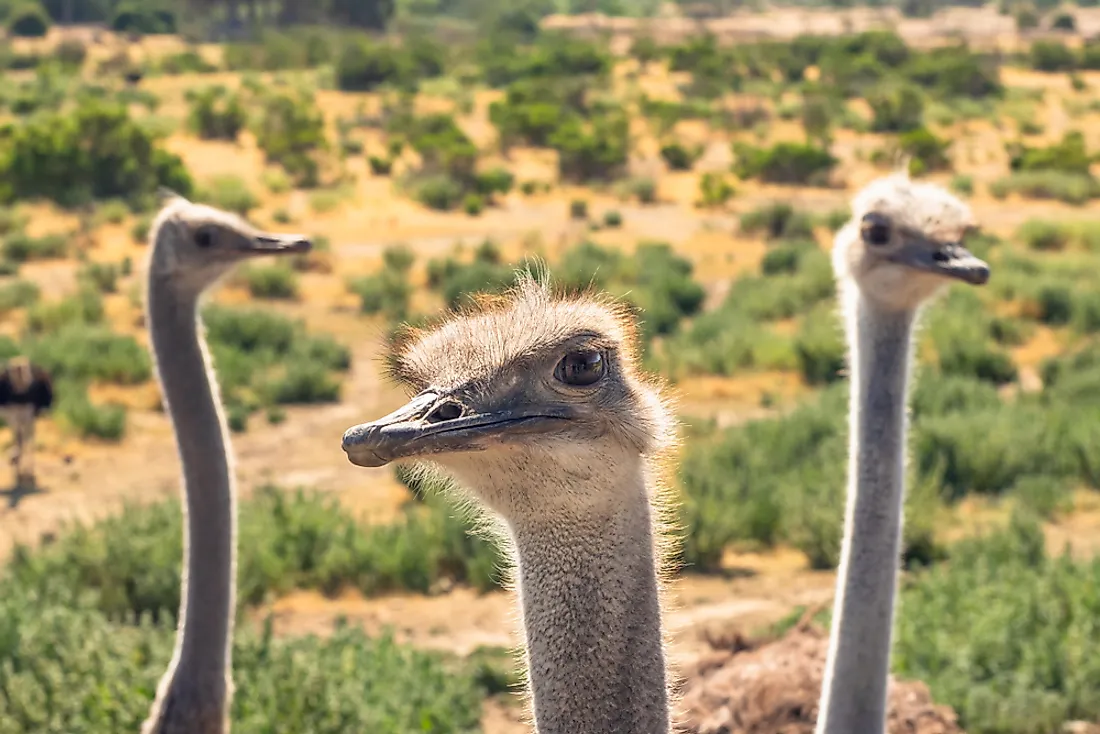What Are The Differences Between An Emu And An Ostrich?

Both the Ostrich and Emu belong to the ratite group of birds. Ratites refer to birds with a smooth sternum or breastbone, which is a raft-like bone. The sternum is smooth because they lack the keel which the flight muscles are anchored. For this reason, all the ratite species cannot fly. Other birds in the ratite group include the kiwi, Rhea, Cassowary, Elephant bird, and Moa. This group has anatomic anomalies, and they are flightless. The Ostrich and Emu are closely related birds with several similar characteristics. Despite their similarity, there are many differences between the two birds.
Differences in Size
Although Emus are the largest birds in their habitats, they are relatively smaller compared to ostriches. Adult female Emus on average weigh between 40 pounds to 132 pounds while adult female Emus weigh an average of 69 pounds, while the male weighs 82 pounds on average, which makes them much smaller compared to fully grown ostriches which could weigh between 220 pounds and 265 pounds. Currently, the ostrich is the world’s largest bird, while the Emu is the second largest. Exceptionally large ostriches can weigh as much as 346 pounds. After two or four years, a mature ostrich male could stand at 6 feet to 9 feet tall and the female could be range from 5 to 6 feet in height. On the other hand, a large Emus could reach a height of 4.9 feet to 6.2 feet in height. Female Emus are slightly larger than male Emus, and they are significantly wider at the rump.
Distribution And Habitat
Ostriches are native to Africa, and they are found mainly in the wild where they inhabit the arid and semi-arid regions like the Savannah and Sahel habitats where they are distributed across the northern and southern zones of the equatorial forest. The ostriches inhabiting the Horn of Africa are known as the Somali ostriches, and they have evolved in isolation from other common ostriches. Even in some regions where the common ostriches like the Masai subspecies have existed alongside the Somali ostriches, ecological and behavioral differences have kept them from interbreeding. In Arabia and Asia Minor, where Arabian ostriches existed, they were hunted to extinction, particularly in the 20th century.
On the other hand, the Emus are native to Australia, and in the past, they were so abundant in the east coast of Australia. The increasing agricultural development in the interior part of Australia has pushed the Emus to the arid areas in the country. The Emus inhabit different habitats across the country, and they are most common in regions of savanna and sclerophyll forests, while they are least common in arid regions and highly populated areas receiving less than 24 inches of rainfall.
Behavior And Ecology
During winter ostriches spend their time in pairs, but during the breeding season or in periods of heavy rains ostriches lead a nomadic life in groups of between five and 100 birds while they are being led by a top hen and they often travel with other grazing animals like antelopes or zebras. They are diurnal, but they could be active at night, especially on moonlit nights. Ostriches are typically active early in the morning and late in the evenings. A typical territory of a male ostrich is an area covering between 0.77 square miles and 7.7 square miles. When ostriches run, they could attain a speed of up to 43 miles per hour, and they are able to sustain a speed of 32 miles per hour, qualifying them as the fastest two-legged animals in the world.
Emus are also diurnal and spend most of their time foraging or dust bathing. Generally, they are more gregarious unless during the breeding season. Emus can swim, and they can cross rivers. They can run fast but not as ostriches, and they are able to attain maximum speeds of up to 31 miles per hour. Emus can travel for long distances, and they are known to go for weeks without food.
Other Differences Between Ostriches And Emus
Emus have deep brown feathers, and it is not easy to distinguish between the female and the male while in the ostriches the male and the female are significantly different. The males have white and black feathers while the females have grayish-brown feathers. Emus have three toes, and they do not run as fast as ostriches. On the other hand, ostriches have two toes, and they run much faster. During mating season, the Emus form only one pair, while among the ostriches, one male mate with about 6 to 7 hens in the territory. The male Emu is responsible for incubating and caring for the chicks, while among ostriches the incubation is done alternately, the dominant female incubating during the day while the male is responsible for incubation at night.











